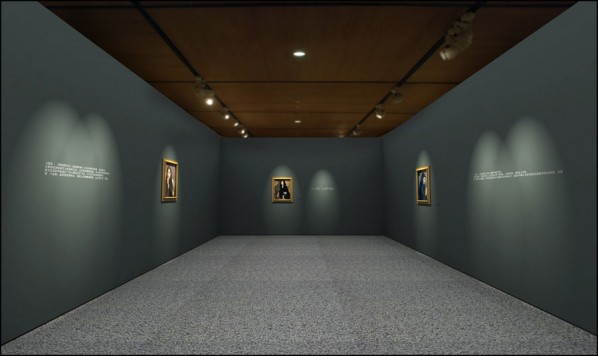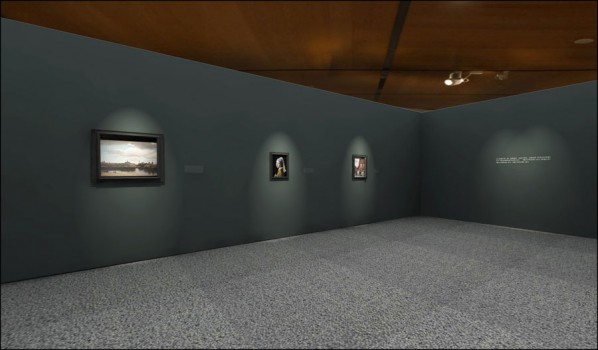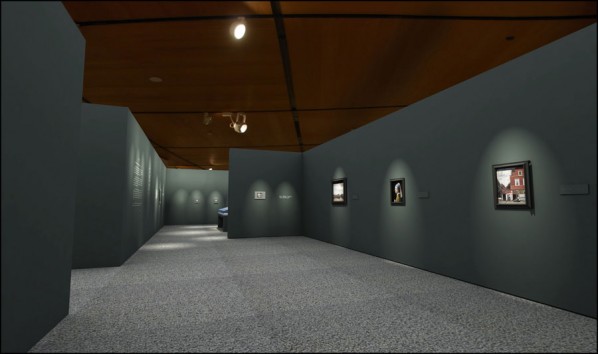As a Chinese artist, Jin has devoted himself to the studies on Western oil paintings and never ceased his pursuit for grasping the unique beauty of oil paintings. Although in his eighties, he still hopes to present the charming oil paintings with his own brushes to meet the skilled levels of masters. Also he conveys his concerns on the contemporary in every work. Thus his three series of paintings—“The Terrified Girl with a Pearl Earring”, “New Landscape of Daierfute” and “The Old Street of Daierfute” which seemingly copied Vermeer’s works but actually intend to pay tribute to this great master were created. There’s only one purpose lies in this small scale academic exhibition: let the students have an opportunity to observe and understand the values of innovation and continuation of traditions. As Xu Bing, the academic host of this exhibition noted, “The charm of the Central Academy of Fine Arts rests with its most rigorous training and most active thinking.” This established academic style of CAFA is completely embodied in this exhibition.

Compliments to Vermeer-Jin Shangyi Solo Exhibition 03
The Following Excerpts are quoted from Thoughts on a Chinese Artist Studying a Western Old Master by Jason Edward Kaufman (find its full version at http://jasonkaufman.info).
Vermeer’s View of Delft (c. 1660-61; Mauritshuis, The Hague) is one of the most admired landscapes in the history of Western art. It shows the Southern Dutch city from the southeast as seen across a small harbor. Jin visited the site and noted how things had changed: the old houses on the left had been replaced with modern structures, the stone gates to the inner harbor at the center and right had been altered, and all that remained of the old skyline were some church towers and the conical turrets of one of the gates.
At first glance, Jin’s New View of Delft could be confused with the original. The composition and scale are more or less the same, and the sky, which fills around two thirds of Vermeer’s canvas, is an exact copy. But on closer inspection the ruse becomes clear. Jin has updated the scene to depict the contemporary townscape, and although he reproduces a barge from Vermeer’s original and the little triangle of land in the foreground, he adds a few figures in modern dress.
He plays a similar game with Vermeer’s The Little Street (c. 1657-58; Rijksmuseum, Amsterdam). Again, the composition is generally the same as Vermeer’s, with the alley and the sky on the left half of the picture copied from the original. But in Jin’s revision, titled Old Street of Delft, the right side of the picture is changed. Jin says that he walked the town in search of the brick house that Vermeer had painted, which still survives, but he could not find it, so he photographed a similar building as his model for the upper right area of the canvas. And for the foreground, instead of the lady in the doorway and children on the sidewalk, Jin substitutes a scene he captured with his camera in another part of town. A man stands next to a motorcycle and there is large photographic advertisement in the plate-glass window on the ground floor.
The third Vermeer that Jin modifies is Girl with a Pearl Earring (c. 1665-66; Mauritshuis, The Hague), a bust of an unknown woman in three-quarter view looking over her left shoulder to the viewer. Jin duplicates the figure’s position, her blue and yellow turban and yellow dress, the glinting highlight on the earring, and the dark background. But he subtly alters her gaze to suggest trepidation and adds in the lower center her left hand brought to her breast. Though he titles his work Terrified Girl with a Pearl Earring, she seems less scared than slightly apprehensive.
In each case Jin has preserved the composition and atmosphere of Vermeer’s paintings, and placed his canvases in Dutch-style black molded-wood frames to further lead the viewer to mistake the variants for the originals. A closer look reveals the unexpected additions and alterations of subject matter, as well as differences in painterly technique. Whereas Vermeer painstakingly built up paintings with many layers of semi-translucent pigments, sometimes melding brushstrokes into an enamel-like finish, Jin employs a more summary technique, describing forms superficially with a single application of carefully selected dabs of paint, each of which remains visible up close.

Compliments to Vermeer Jin Shangyi Solo Exhibition 01
What led Jin to focus on Vermeer? In his travels to European and American museums, Jin was most impressed by Rembrandt and Vermeer. “My personality is somewhat different from Rembrandt’s,” he says, “but I think I share the same characteristics of personality with Vermeer, which makes it easier to paint works that look similar to his.” Vermeer exudes a “quiet and tranquility” for which Jin feels an affinity.
Jin’s primary purpose in visiting Western museums was to learn how the Old Masters painted, but he says that copying these three works was not about studying technique. “It’s a different issue,” he says. “I want to express an idea: specifically, my puzzlement with contemporary society, my being unable to adapt to the fast-changing world, particularly in China.”
“Because I grew up in these times of change,” he says, “that is why I am puzzled. And I think many young people also cannot adapt to the world. Young people are having psychological problems -- problems that in China are more serious than in other parts of the world -- because the changes are so rapid that you cannot adapt to them. The contradictions are very acute. This perspective is what makes me different from other people,” he says.
In his updates of the Vermeers, Jin attempts to express his unease. “I combined together the modern and the old,” he says of his New View of Delft and Old Street of Delft. “And when I looked at [Girl with a Pearl Earring], I wondered, if the girl had lived long enough what would she feel about this fast changing world? I thought that she would have felt very disturbed, too,” he says. Jin gives his version of the girl a troubled look, and acknowledges that she is a surrogate for him, looking at the world with a little fear.

Compliments to Vermeer-Jin Shangyi Solo Exhibition02
Image Courtesy of CAFAM
As a professor at the Central Academy and other schools, Jin helped develop the oil painting curriculum that has trained generations of Chinese artists. Some of his students – and their students in turn – adopted the conventions of Classical Realism. Others developed more contemporary variations of painting that have become more highly regarded in international art circles. The work of China’s most successful contemporary painters, though quite distinct from Jin’s, might not have developed so rapidly without the presence of academic courses in the techniques of oil painting that Jin helped to establish.
Yet, Jin is the first to admit that new forms of expression are valid reflections of the modern condition. “I like Western modernism from Impressionism to Abstraction,” he says, singling out in particular Henri Matisse, Pablo Picasso, Egon Schiele, Alberto Giacometti, and Francis Bacon. And he has great sympathy for contemporary artists, as well. “Some young painters paint like [me], but most use modern and contemporary approaches because they can better reflect their agitated emotions,” he says. “They start from realism and eventually they learn expressionism and abstraction and they transform. I agree with them,” he says. “I want to do it, too, but it’s easier for them. I am not familiar with the language and it’s very difficult to turn from detailed depiction to a more expressive approach. I painted expressive works when I was young, then turned to classicism. Now,” he says, “if I turn again it would be hard. I don’t have the energy. It’s simple – I’m old.”
In his late career, as China opens itself to more Conceptual approaches current in the international art world, Jin finds himself at odds with prevailing attitudes. He likes the Realist paintings of Liu Xiaodong (b. 1963), but not all contemporary art appeals to him. “If you don’t have Realism as a foundation you cannot paint abstraction or expressionism well,” He says, citing several celebrated Chinese contemporary painters. According to Jin, “What is lacking in China is not thinking, but technique. No matter how good your idea, without the proper technique you cannot realize it.” But as Classic Realism drifts ever further into the past, and the speed of change continues, we might ask if Chinese art schools should abandon Realism and focus instead on teaching contemporary modes of expression. Jin believes there is room for both Classic Realism and Modernism, as well as for traditional ink painting. He is right, of course. With its easy-to-read imagery and admirable technique, there is still demand for Realism in China and abroad, and there will be for years to come. “I have no doubt in the future existence of oil painting. Oil painting is still something new for the Chinese,” he says, “and the more the Chinese see the more they will like it.” But as the Chinese audience becomes increasingly familiar with new technologies and sophisticated alternative forms of expression, their aesthetic horizons will expand to encompass not only the Classic Realism of Jin, but new forms of art as yet unknown.
About the Writer
Jason Edward Kaufman is an art critic and cultural reporter based in New York. His writing has appeared in The Washington Post, The New York Times, The Wall Street Journal, The Los Angeles Times, The Art Newspaper and numerous other publications. For more information and to subscribe to his IN VIEW Culture Bulletin, visit http://jasonkaufman.info/INVIEWBlog.htm.
View the Chinese version of this article here




























